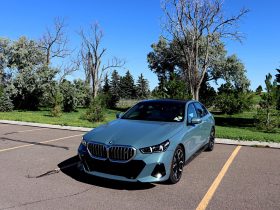For the first time ever, Italdesign, Schindler, and Politecnico di Torino will be attending CES 2023 in Las Vegas with an innovative autonomous driving concept that can guarantee a seamless private travel experience and a series of services straight to people’s doors, thanks to its complete capacity to integrate into next-gen and future civil and residential building structures. Further development of the project will lead to adapting the concept to historical buildings and architectural heritage, too.
The project is called Climb-E and was created from the collaboration between Italdesign, the Schindler group, a leader in the elevator, escalator and moving walkways sector, and the Politecnico di Torino – Department of Architecture and Design, and Interateneo Department of Land Science, Design and Policy. This project confirms Italdesign’s role as a “technology enabler and hub,” capable of uniting different industrial sectors to promote and develop innovation, as already happened six years ago with the Pop.Up project.
Climb-E is a complete project that foresees a possible future urban scenario directly linked to evolution in the concept of local sustainable urban mobility into continuous sustainable urban mobility.

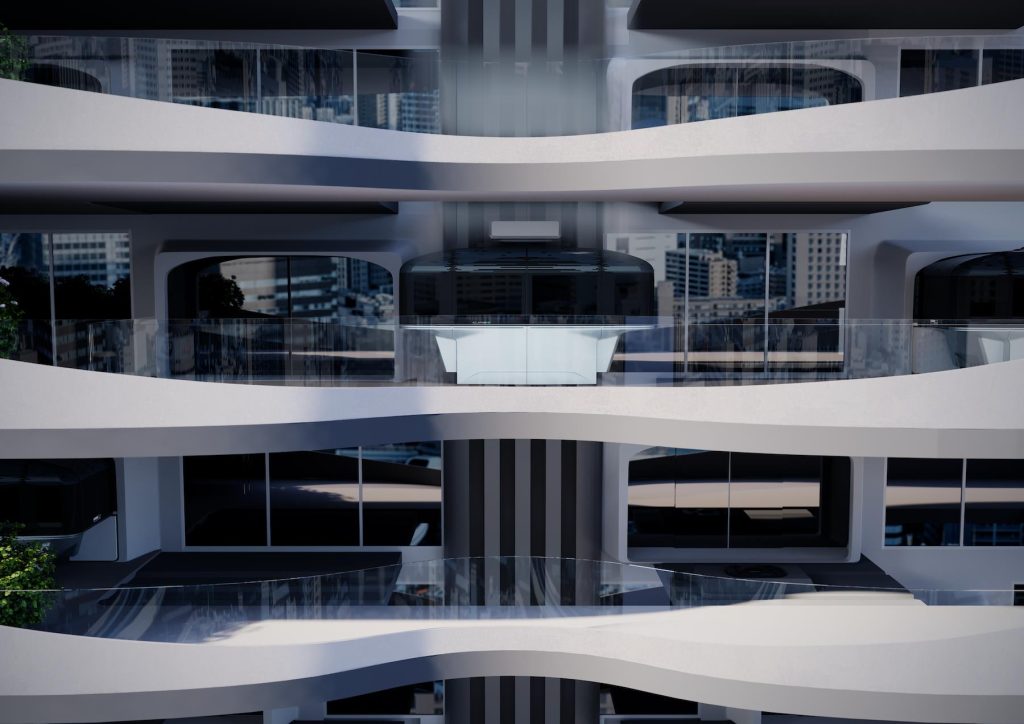
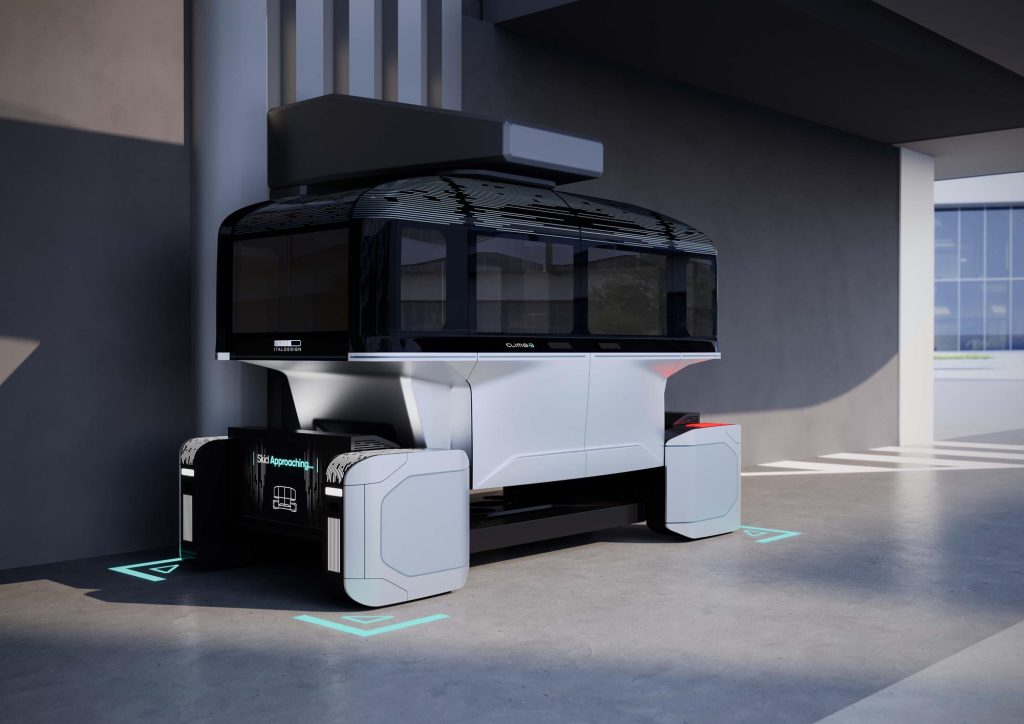
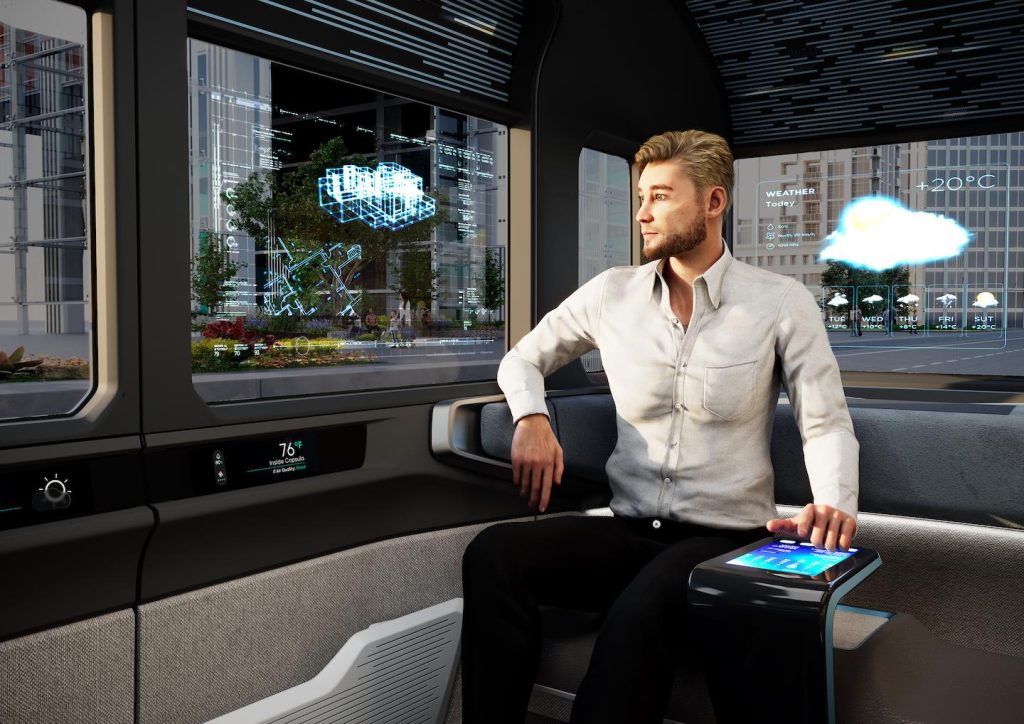
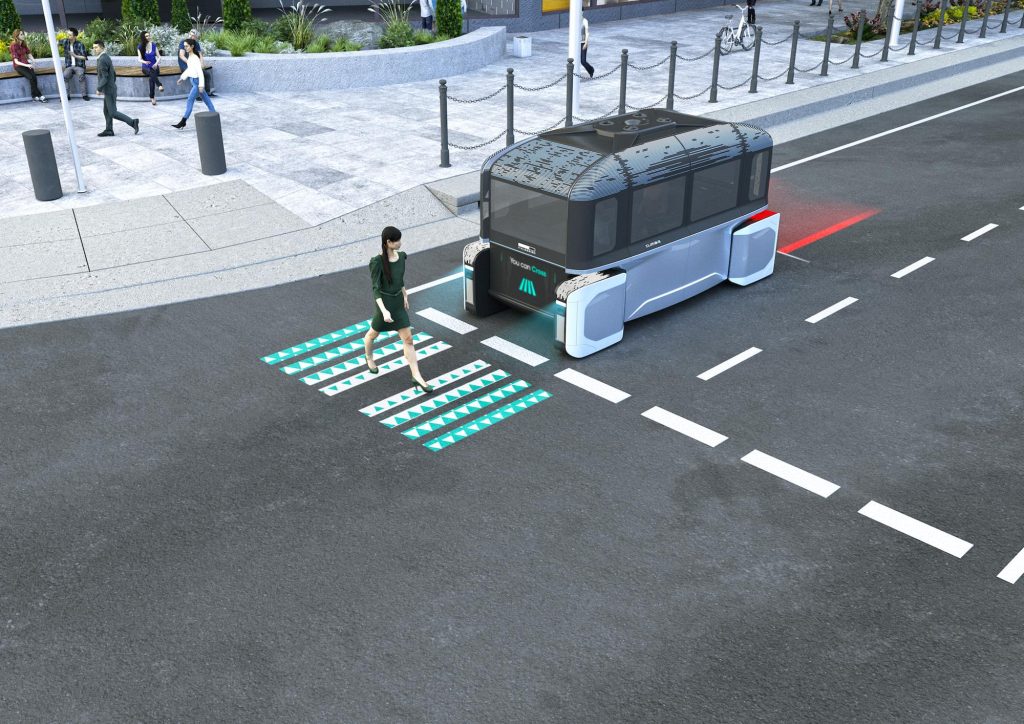
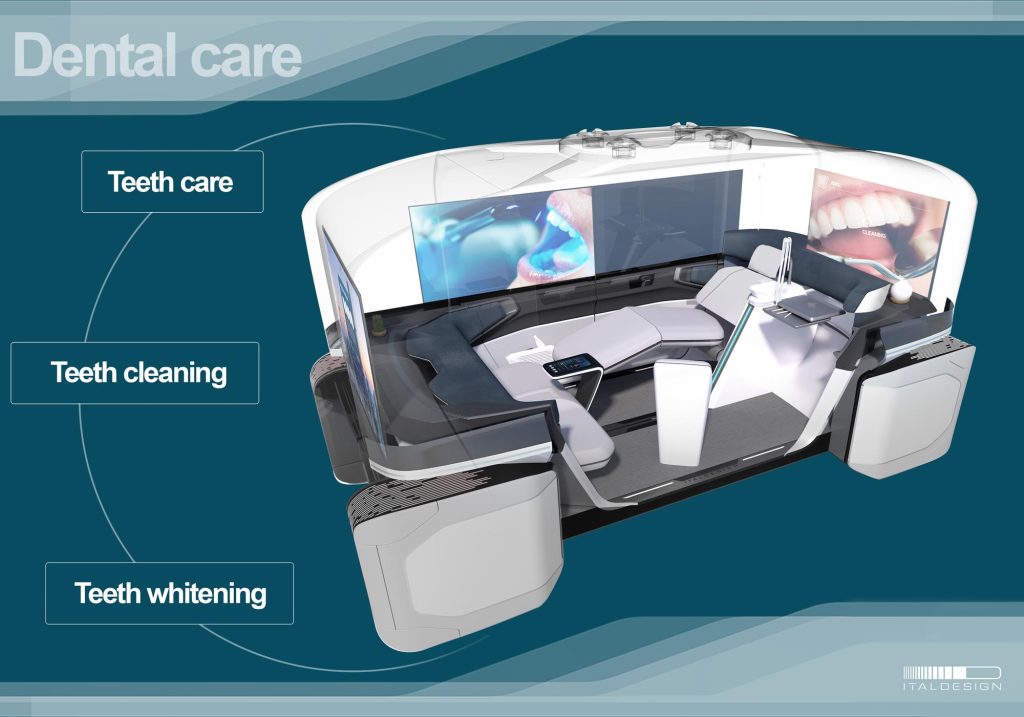
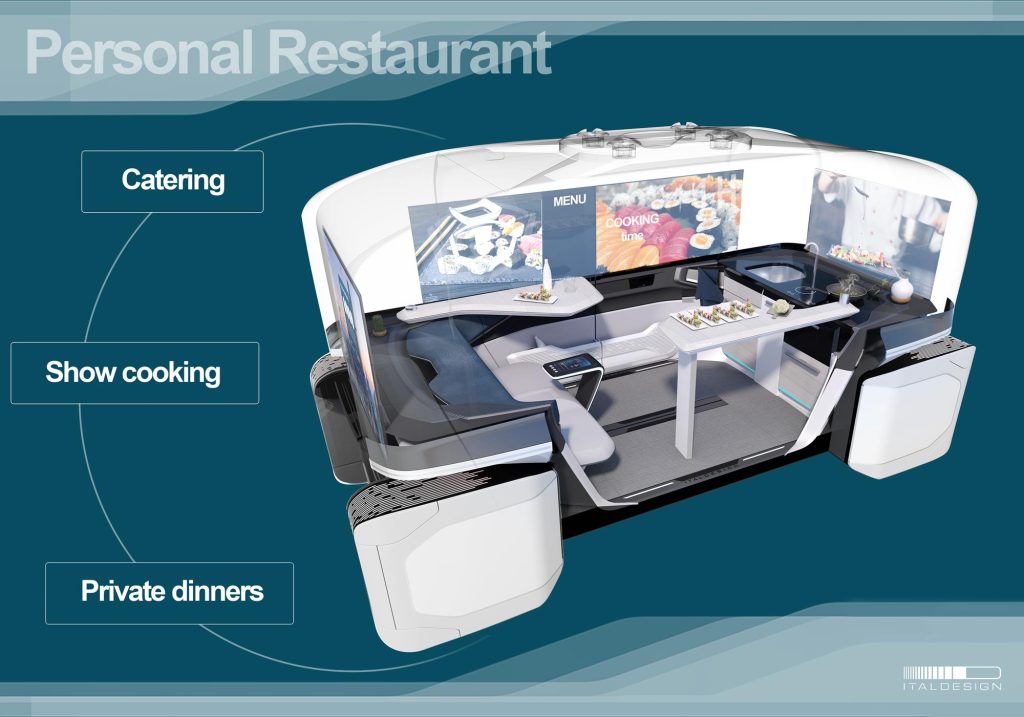
Climb-E – THE CONCEPT
The project’s philosophy
The philosophy behind the Climb-E concept goes back to the experience of seamless transport already introduced in 2017 with the Pop.Up project and in 2018 with the Pop.Up Next evolution. This concept is joined by the innovative idea of offering various services straight to users’ doors.
Climb-E offers the possibility of traveling by starting right from your door or place of work, staying in your private environment without ever having to change vehicle, while also guaranteeing maximum comfort and completely breaking down any possible architectural barriers, an increasingly topical and sensitive issue in the development of urban areas.
Climb-E is a modular means of transport formed of a capsule, designed for private use, which can transport in standard configuration up to four people and can be coupled, when moving, with a fully electric platform (hereinafter called the skid), which is not owned but rather shared and features autonomous driving. The truly unique added value of this concept is the capsule’s capacity to find its natural place as an integral part of various residential or working locations, becoming an additional room and/or extension.
Alongside private use of the Climb-E concept, the modular nature of the project allows for many different configurations that can offer a functional and exclusive private/public service. In fact, the capsule’s interior configurations allow for many public services to be offered to private users right at their homes. The range of home services is endless: basic medical assistance services, telemedicine medical analysis or dental care, catering and show cooking services for private events, fully equipped home massages, home sales of various products, veterinary and pet grooming services, and much more.
The entire system is managed through a special app that lets owners book their trip either around or out of town or book a specific service. Scheduling a journey involves collection of the capsule right from your apartment, condominium, or office thanks to the system of hoists developed by Schindler and the subsequent transfer to street level to be coupled with the skid that is always pre-booked through the app. Once you have reached your destination, the capsule is released from the skid to be coupled either with another hoist for positioning up to the right floor of the intended building (residential/office) or with another carrier for longer journeys, such as the hyperloop.
Once their service cycle is finished, skids can fulfill bookings from other users, or they can return autonomously to their charging and parking stations, so they are available for future calls.
Integration with architecture and the city – The vision of the Politecnico di Torino Faculty of Architecture and Design and Inter-University Department of Regional & Urban Studies and Planning
Climb-E, in its dual function of transport and home or office extension, creates a new connection between mobility and architecture: a hybrid between a means of transport and a home, high-performance and high-tech but also welcoming and inviting.
When it is at home, the capsule extends a living room or bedroom, offering a cozy space that you can use, for example, to watch a movie, play with the kids, follow an online fitness class, see an exhibition in the metaverse, or do some work. When it is at the office, it becomes a small meeting room for select gatherings or private calls.
Climb-E brings new, advanced technological equipment into the living or working environment, improving the quality of architectural spaces and services.
The integration of the capsule into the front of buildings also is a new architectural feature. In fact, it turns the traditionally motionless urban face of buildings into a changeable, moving system. When ascending, Climb-E has full functional autonomy compared with other vertical mobility systems, guaranteeing privacy and fast movement. However, at the same time, it can intersect with the vertical layout of stairs and elevators, offering the building front a 3D look and quality space. Another new architectural feature that Climb-E brings with it is the option of using lighting inside the capsule or graphic effects on the outside of the glass to enhance the front with messages, logos, and colors, transforming it into a sophisticated display.
In the case of homes, the capsules can directly reach the owner’s residence, while for offices they can be assembled in hanging lobbies on various floors of the building, forming exclusive lounges that become additional spaces to host small meetings or for complete privacy.
When the capsule is for private use, the skids remain with the company that manages the service: when unused, they can be gathered into underground containers or silos built in disused spaces around town (junctions, abandoned areas, etc.), therefore complementing urban planning without sacrificing important areas in terms of real estate or public use.
Another important aspect of the project, from a mobility point of view, is the interface with other means of transport.
From an architectural and urban point of view, you can imagine several future developments. In its previously mentioned use on existing recent or even historical buildings, the aspects of vertical mobility offered by the capsules can also help guide other technological and system upgrades. You can also set up more public use for the capsules initially intended only for providing home services: catering, medical services or even DJ sets in open spaces around town, organized flexibly to optimize use of these capsules over 24 hours.
Schindler vision
Schindler has a long heritage of innovation stretching back almost 150 years. Its solutions are modular and energy efficient, guaranteeing a seamless and interactive user experience. Schindler’s solutions make buildings safer, more efficient, sustainable, and enhance urban living for current and future generations.
Technical innovations are changing mobility in cities. New forms of mobility will have to be more sustainable, efficient, and designed to meet our changing needs. Autonomous driving, connectivity, and integrated mobility paired with sustainable solutions will strongly impact the way people live and move. Cities and buildings will have to adapt to these transformations. Schindler supports elevating future-concepts and ideas to enhance urban infrastructure for the good of their customers, the broader society, and the environment as a whole.
Italdesign and Schindler are collaborating in this co-innovation project to design new mobility possibilities combined with urban infrastructure. The concept is based on a modular system that includes autonomous skids, an elevator frame, and personal capsules. This modular system of capsules that can autonomously move vertically but also horizontally creates new opportunities for future cities. Seamless autonomous travel from door to door offers comfort in a completely new dimension. Personalization of the capsule offers mobility on a new level, where car space, elevator space, and flat space become one. With this project we are jointly rethinking building and façade design, as well as solving everyday city problems like traffic jams or limited parking slots by means of connectivity.
The exterior design of the capsule
Thanks to its autonomous driving and electric power, Climb-E can travel in both directions. The exterior design of the capsule stands out with the complete symmetry of its form, expressing the dual nature of the capsule’s mobility. Climb-E has completely abandoned the classic concept of vehicle style with a driver that requires a front and a rear.
The design of the sides, which develops upwards, focuses on maximum accessibility to guarantee that the interior space is completely livable and usable.
The sides feature clear separation between the lower body, made from composite material, and the upper one, formed by a large window that ensures the passenger compartment is nice and bright while also guaranteeing maximum privacy thanks to the option of completely blocking out the glass.
Both sides of the capsule feature two pairs of pivot doors that can integrate into the docking station in the host building, providing excellent access inside the capsule even for those who use wheelchairs or have mobility challenges.
The exterior part of the doors, on the surface that separates the upper glass area from the bottom part, features proximity and automatic recognition sensors for the registered users as well as four small LED screens that let you customize welcome on-board messages or can display functional messages.
The roof features soft lines with large, continuous screen-printing that conveys energy and speed, thanks to a series of parallel lines that create continuous strips, which can be found with different functions and styles, all over the vehicle, both inside and outside.
The top part of the roof features a four-point attachment system that, when coupled with the lifting system designed by Schindler, lets you move the capsule vertically from various levels on host buildings down to street level for coupling with the skid.
The exterior color is metallic light blue with a combination of gloss and matte paints to create a “tone-on-tone” effect that enhances the feature lines and exterior surfaces of the bodywork.
The four-point latching system with the skid for on-road travel is housed in the underbody of the capsule. This system is like the one used on the roof for fastening to the elevator and is the evolution of the system developed with the Pop.Up project in 2017.
This Climb-E latching system solution is taken from Italian Patent Application N. 102018000010623 (Applicant: Italdesign) in 2018. Moreover, a new Patent Application has been just filed (Applicant: Italdesign), focusing on projecting system of ground-module self-driving capsule.
This new Patent Application (projecting system of ground-module self-driving capsule) and Design Patent Exterior and Interior are applicable on vehicles in general, especially for autonomous driving.
The interior design of the capsule
The interior offers the same symmetry as on the exterior and allows for great flexibility of use.
The capsule’s windows include semi-transparent screens that let you use a wide range of multimedia content. By using the cloud, the capsule can be configured based on the personal profiles of the various users before they get on board, therefore guaranteeing a seamless experience even for the UX & HMI system. Various configurations of the screens and the relative contents can be used at the same time if several passengers are on board.
Managing all the multimedia content, the home automation functions, the lighting, and the air conditioning inside the capsule can be done via two touchscreens in front of the two sofas or by voice control.
The two seats, positioned perpendicular to the two directions of travel, feature a minimalist design. The passengers sit vis-à-vis so to comfortably interact with the screens, both on the sides as well as those on the front and and rear surfaces. The backrests, detached from the seats and integrated with part of the sides and the doors, create an enveloping, continuous environment. The surface behind the backrests can be reconfigured allowing it, when sitting frontwise, to be used as a desk.
The inner door surfaces, like the exterior, have four small service screens for on-board content: interior temperature, welcome messages, etc.
The interior compartment and pillars incorporate the same screen-printed system or LED strip lighting that is found on the exterior top part of the capsule. The dimmable RGB lighting adapts naturally to the mood set by the users or to the content projected onto the screens to always guarantee the highest viewing quality.
To ensure the highest levels of privacy, if necessary, all capsule glass surfaces are fitted with an automatic blackout system that completely eliminates any glass transparency.
The lower part of the car door includes four storage compartments that let you store small/medium-sized items.
The seats of the two sofas can rotate and slide forward like a chaise lounge, or they can be tipped upwards to make room for loading medium/large-sized objects (luggage, bikes, etc.).
Color & Trim
Special attention has been paid to the Color & Trim. The capsule’s interiors, with their clear minimalist style, allow for general customization and matching with the style and furniture of the venues where it is incorporated.
The interior upholstery has extensively used eco-leathers, recycled polyester materials, Alcantara, and new technologies widely used in the fashion sector to customize materials, therefore giving complete free rein to designers’ creativity. More specifically, the seats of the two sofas are made from eco-leather in a light color to amplify and reflect light and to expand the interior space. The sides’ lower areas are upholstered in 100 percent recycled polyester made by Camira. It also is worth noting the technology used to add graphics onto the rear horizontal backrest surfaces are covered in Alcantara fabric. Created by Stratasys, customization is done through 3D J850 TechStyle printing directly onto the fabric using plastics compatible with approved standards.
When configured for home public services, the interior’s minimalist design allows for completely free configuration and installation of equipment and instruments depending on the functions. The wide choice of materials makes it easier to clean and sanitize the interiors, which becomes a priority for this use, compared with the purely architectural and aesthetic aspects of versions for private use.
The Skid
The design of the skid is mainly guided by functional aspects linked to its use. As it is a tool designed for shared and not privately-owned mobility, the style is functional for the service that the platform has to guarantee.
The four steering and driving wheels are positioned overhanging the platform. To guarantee the hallmark aesthetic symmetry and cleanliness of the entire Climb-E project, the wheels are fully integrated into the square casings that completely hide the tires and incorporate various lights, headlights, and different functional and active and passive safety devices.
The two short sides of the skid feature two 43-inch multifunctional screens that can be used for both functional messages and traffic warnings and for fun messages that can be customized by passengers.
The battery pack is housed in the central part of the floor, positioned very low down and under the capsule latching system, therefore guaranteeing a very low center of gravity and better use of vertical spaces for passengers. The batteries are lithium-ion [LI-ION] and guarantee a range of 200 miles (322 km). Inductive charging is guaranteed automatically (fast charge in 15 minutes for an 80% charge) inside various storage silos located in specific urban areas and in the underground floors of various buildings.
Multifunctional ground projection devices are built into the forward-facing part of the casings of the four wheels. The main function is to communicate with pedestrians and human-driven vehicles, indicating functional service messages.
One example is the projection onto the ground, outside of any existing crossing areas, of dynamic crosswalks to inform pedestrians of their right of way and the possibility of crossing and to warn them about any other vehicles that may be passing but cannot be seen. When the vehicle is entering the flow of traffic, the system projects dynamic images onto the ground indicating the stationary start of the vehicle and the turning radius for entry.
At the top front part of the four casings for the wheels there are also several sets of lights that can be reconfigured depending on the direction of travel, operating mode, charging and stand-by mode of the skid. The style of these lights evokes the ones of the lighting strips and screen-printing found on the top part of the capsule and its interior.
The lighting of these strips varies depending on the skid’s operating mode: continuous soft light when it is in stand-by to be coupled with the capsule, white and red lights on the two short sides depending on the direction of travel, and flashing blue light at a variable and incremental frequency when the capsule is descending and coupling.
In the lower part of the fairings, in front of the wheels, there are four AIS 2 (Aquaplaning Intelligent Solution) system injectors by Easyrain, Italian innovative startup working in safety sector.
Easyrain safety ecosystem
Climb-E includes the entire Easyrain safety ecosystem, capable of providing active support to detect the grip offered by the road surface, restoring any traction and sharing information on the grip with vehicles, infrastructures, and companies.
In order to detect the grip, Easyrain has developed and patented Digital Aquaplaning Information (DAI), an innovative piece of software that uses the network included as standard on board the car. By analyzing the car’s parameters and driving dynamics, DAI recognizes hazardous situations linked to driving on wet surfaces in just a few milliseconds and generates an alert message. Car makers can use these alerts to add new features to help with driving, such as automatically reducing the acceleration speed on very wet roads.
DAI does not require calibration and works with any tires (regardless of wear and tear, inflation pressure or tire tread pattern), so it has everything it needs to create a new generation of advanced driver assistance system (ADAS) that can automatically adapt depending on the grip offered by the road.
DAI detects the level of grip on the wet road, but software is already being developed to drive on snow, ice, gravel, and potholes.
In the case of aquaplaning, DAI provides the Aquaplaning Intelligent Solution (AIS), the first active system in the world that changes road conditions. Through a controlled jet of water, sprayed before the front wheels, AIS breaks the layer of water that causes the tire to float and allows the tire itself to recover its grip with the road, therefore helping the driver to regain full control over the car. The AIS system can be easily integrated into the vehicle and can be customized by the manufacturer, depending on criteria such as the required performance and retail price.
AIS was created as an anti-aquaplaning system, but additional developments are planned: Easyrain is developing the next generation, known in-house as AIS Proto-B, which can eliminate the loss of grip on wet surfaces and even on snow and ice.
The Easyrain ecosystem is completed by the Easyrain Cloud (ERC), which was designed to extend the features of DAI and to take advantage of the power of data sharing: the information collected by DAI can be used internally to refine the detection algorithm, or shared with various players in order to allow services such as predictive maintenance of the road network or the replacement of a car part as soon as the first signs of wear and tear appear. Last but not least, the information collected by DAI and shared by the ERC will be used to inform motorists of any hazards before they occur on the hazardous section of road.






